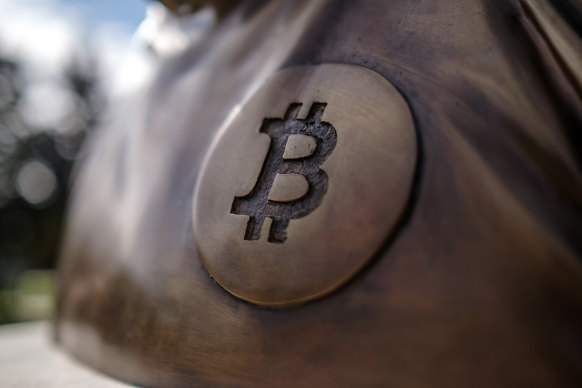
Wright, 53, had a financial interest in squelching their work: He and a gambling tycoon had joined forces to promote an alternative digital currency that they claimed was a pure, uncorrupted version of bitcoin, with better practical applications.
This year, bitcoin’s price surged to an all-time high. But the crypto industry is still tarnished by a procession of recent financial scandals that cost investors billions in savings. The mystery of Satoshi is the last remnant of a more innocent time in its history.
Wright’s claim to Satoshi-dom wasn’t simply an antagonistic legal strategy: It was a threat to the purity of that founding myth. This year, several of crypto’s most powerful companies mobilised to stop Wright from bringing cases. An influential group led by Coinbase, the largest US exchange, and Block, a company started by Twitter founder Jack Dorsey, took him to trial in London. They were seeking a judicial declaration: we may never know for sure who invented bitcoin, but it wasn’t Craig Wright.
A financial lifeline
Much of what is known about Satoshi Nakamoto comes from hundreds of messages he exchanged with early collaborators, including Gavin Andresen, an American software developer who helped promote bitcoin in the media. In emails and forum posts, Satoshi wrote about his commitment to privacy and his frustrations with the financial establishment, while revealing little about his background.
Then in 2011, Satoshi went silent. Over the next few years, his identity became a tech-industry obsession.
“You can’t help but be pulled into this black hole – the gravity of it is so enormous,” said Andy Greenberg, a long-time tech reporter. “Satoshi’s identity is one of the greatest mysteries in the history of technology.”

In 2008, a person using the pseudonym Satoshi Nakamoto published a white paper explaining the basics of bitcoin, a clever idea that eventually became the foundation of a multitrillion-dollar industry.Credit: Getty
Hardly anyone had heard of Wright until 2015, when Greenberg co-wrote an article for Wired arguing that Wright was probably Satoshi. The article was based partly on private emails and transcripts supplied by an anonymous leaker.
Wired did not reveal its source, and Wright has denied he was behind the leak. At the time, he was operating on the margins of the crypto industry.
He was also in serious financial trouble. By early 2015, months before Wired published its article, he was locked in disputes with the Australian tax office, court records show.
Wright needed a lifeline. A former colleague put him in touch with Calvin Ayre, a Canadian entrepreneur who had made a fortune in the sports betting industry and wanted to invest in crypto. In 2012, the US Justice Department charged Ayre with operating an illegal online gambling business. He pleaded guilty to a misdemeanour and avoided prison time.
Before Wired’s article came out, Wright met with Ayre. He and a business partner made plans to offer financing to Wright and publicise his Satoshi claim. The eventual deal included a loan of $2.5 million to resolve Wright’s tax problems. It also made Wright the chief scientist of a new company, which would have “exclusive rights to Craig’s life story”.
But when the Wired article appeared that December, it drew a sceptical reaction. Wright hadn’t given an interview. And in any case, there was only one definitive way to prove that he had written the white paper: the genuine Satoshi would have access to cryptographic keys unlocking his bitcoin stash.
Wright’s sponsors devised a plan to prove that the Satoshi claim was genuine. In 2016, they flew Andresen to London, hoping to secure the endorsement of Satoshi’s old collaborator. Wright gave a demonstration meant to show Andresen that he controlled Satoshi’s private keys.
Andresen was impressed. In a blog post titled “Satoshi” he gave his endorsement, saying Wright’s demonstration proved he had invented bitcoin.
Wright’s backers saw an opportunity to profit. Soon, Wright was supposed to make the cryptographic proof public and end the Satoshi mystery forever. But when the day arrived for the big reveal, Wright didn’t offer any proof.
Why claim to be Satoshi?
Hardly anyone knows as much about Craig Wright as Arthur van Pelt. A prolific blogger, van Pelt is the dominant figure in a corner of the internet where obsessive historians of the Satoshi saga dissect Wright’s legal campaign.
Van Pelt returns repeatedly to a key psychological question: What would motivate someone to insist that he invented bitcoin if he hadn’t?
Over the years, van Pelt said, he has weighed various possible answers, from fame and money to family trauma. In one lawsuit, Wright ordered up a medical declaration from a psychologist who had diagnosed him with autism and who described his struggles with a “volatile” and “abusive” father.
Loading
Even after Wright failed to produce the evidence, he retained a band of loyal online followers. He didn’t have access to Satoshi’s private keys, he claimed in court, because he had smashed a hard drive containing them; he described it as an impulsive decision, partly related to his autism.
Ayre stood by him, and in 2018, he and Wright launched Bitcoin Satoshi Vision.
Wright pressed his claim to Satoshi-dom in the courts. By 2022, his defamation battle reached Norway, where Magnus Granath, a little-known bitcoin enthusiast who had accused him of fraud on social media, won a judgment against him. That year, Wright also sued the bitcoin coders, claiming copyright infringement.
“He seems to have enough money and backing from others that he can make good on his threats to ruin people financially by bringing expensive litigation,” Steve Lee, a manager at Block, said in a court filing last year.
Lee was part of a coalition of prominent crypto companies called the Cryptocurrency Open Patent Alliance, or COPA, which was founded to stop patent rules from preventing the development of crypto technology. In 2021, Wright’s lawyers asked COPA and its members to remove the bitcoin white paper from their websites. COPA responded by suing Wright in High Court in London, seeking a ruling that he did not invent bitcoin.
As the litigation intensified, Christen Ager-Hanssen, a venture investor, joined nChain and helped oversee Wright’s legal affairs. Last fall, he switched sides, saying he didn’t believe Wright’s claims.
In an interview, Ager-Hanssen said Wright struck him as clever but delusional. Still, he said, he found it hard to understand why Wright has spent so many years trying to prove that he invented bitcoin.
“This is my biggest question,” Ager-Hanssen said. “I believe he thinks he deserves to be Satoshi.”

This year, several of crypto’s most powerful companies, including Block, co-founded by Jack Dorsey (pictured), mobilised to stop Wright.Credit: Bloomberg
A judge decides
At first glance, the page of notes scrawled on a Quill pad looks like an artefact of potentially historic significance. Dated August 2007, the notes summarise a meeting that Wright held with a colleague in which he discussed a new form of digital money. A list of follow-up steps mentions a “paper,” set for publication in 2008.
The notes were part of a cache of more than 100 “reliance documents” that Wright filed as evidence that he invented bitcoin. Before the trial in High Court began in February, a forensic expert hired by COPA submitted to the court an analysis finding that the vast majority of the documents had been doctored.
As the trial reached its conclusion in March and Wright’s legal team tried to address the forgery claims, Ayre began texting a New York Times reporter. The trial was “old powers wanting to slow innovation,” Ayre wrote. He said only a “moron” would disbelieve Wright.
A few minutes later, the judge overseeing the proceedings, James Mellor, issued a ruling. “Dr Wright is not the person who adopted or operated under the pseudonym Satoshi Nakamoto,” he said.
Loading
This week, Mellor elaborated on his conclusions, finding that Wright had forged numerous documents. Wright has already dropped his defamation claim, as well as one suit he filed against bitcoin developers. But he said he planned to appeal the COPA ruling.
The mystery of bitcoin’s creation seems likely to endure. One morning, in the final stretch of COPA v Wright, a blonde man in a baseball cap shuffled into the gallery, taking a seat among a group of reporters before striking up conversation. At first, he revealed little about himself, other than his devotion to personal security. A back brace he had started wearing after a motorcycle accident served as a convenient “stab vest,” he explained – no knife could penetrate it.
But why had he shown up to Wright’s trial? He leant in to whisper a secret: He was the real Satoshi Nakamoto.



























